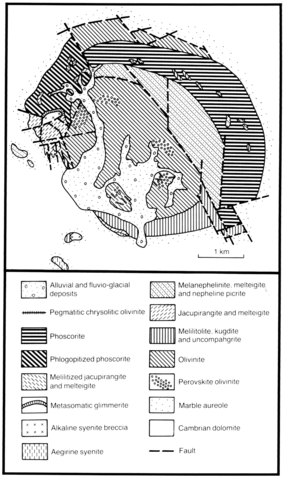stripes
The Kugda complex is situated close to the eastern bank of the Kotui River 25 km southeast of the Odichincha complex and is located at the intersection of the Kotui and Kugda faults. The country rocks are middle Cambrian dolomites which have a sub-horizontal attitude, with no evidence of disruption by emplacement of the intrusion. A metamorphic aureole 200-300 m wide surrounds the complex which has a circular form and an area of about 16 km2. According to magnetic survey data the contacts of the complex dip southeastwards. The morphology of the complex expresses the concentric disposition of the principal rock types, which are olivinite, jacupirangite-melteigite, melilite rocks and phoscorite breccias. Unlike the Odikhincha occurrence, ijolites are developed insignificantly; alkaline syenite and veins of calcite rock are present here. The rocks of the first intrusive stage, medium- to coarse-grained olivinites, compose a stock-like body in the nucleus of the complex, which has an area of 2x3 km. The olivinites consist mainly of weakly serpentinised olivine, titanomagnetite, chromite and spinel; calcite may also be present. A noteworthy feature of the complex is enrichment of the olivinites in ore minerals, the content of which is generally 5-10%, but in some places reaches 20-50%. A subhorizontal layering of the ore-rich olivinites is apparent, which is expressed by rhythmic ore-rich layers 0.2-2 cm thick. Schlieren composed of up to 30-40% titanomagnetite and perovskite are also encountered. Thick, vertical veins of pegmatitic olivinite with phlogopite, clinohumite and gem quality chrysolite are localised in the middle zone of the olivinite nucleus. A marginal facies, with a width of up to 300-500 m, of fine-grained olivinite impoverished in titanomagnetite can be traced along the outer contact zone. In the southern part of the complex the olivinite nucleus is separated from the country rock dolomites by an arcuate body of melilite rocks of the second intrusive stage. These rocks are composed of melilite, olivine, clinopyroxene and nepheline and, depending on the ratios of the constituent minerals, the melilite-bearing rocks can be classified as kugdite, melilitolite or uncompahgrite. Titanomagnetite, perovskite, phlogopite, titanium-bearing garnet, monticellite, apatite, wollastonite and calcite are present as minor phases. In the kugdites of the southern part of the body thin veins of turjaite and micro-turjaite, having intrusive contacts, have been found. The melilite rocks in the contact zone with dolomite acquire a basaltoid appearance. The kugdites and uncompahgrites contain an abundance of olivine xenoliths. Melanocratic alkaline rocks having an area of outcrop of about 7 km2 are widespread in the western and eastern parts of the intrusion and trachytic jacupirangite and melteigite, which pass gradually into melanephelinite and olivine melanephelinite, are dominant among these rocks. They are composed of pyroxene, varying in composition from diopside to aegirine-diopside, nepheline and titanomagnetite. Olivine, phlogopite, titanite, perovskite, melanite, apatite, cancrinite, zeolites and calcite are minor constituents. In the contact zones melteigite usually passes into jacupirangite. A post-magmatic process of nephelinization in some places has transformed the rocks into small patches of taxite ijolite. All the rocks of the jacupirangite-melteigite series contain xenoliths of olivinite and melilitic rocks. Lens-like bodies (100-200x500-800 m) of ijolite are located in the southern part of the massif at the contact of the melilite rocks with dolomite. These rocks are composed mainly of pyroxene, varying from diopside to aegirine-diopside, and nepheline. Titanomagnetite, apatite, titanite, biotite and perovskite are the minor constituents. There are no sharp boundaries between the jacupirangite-melteigite and ijolite series within the Kugda complex. However, a sharp boundary does occur between trachytic melteigite and non-trachytic ijolite in the satellite of the Kugda massif (Fig. 120), which constitutes evidence of two-stage intrusion of a nepheline-pyroxene melt. Thus, the jacupirangite-melteigite suite could be attributed to the third, and those of ijolites to the fourth, intrusive stage. A small stock of 200x500 m and series of dykes of peralkaline aegirine syenite cut the massif in its northwestern part across a direction defined by their trachytic fabric. They are surrounded by a wide contact zone of syenitized rocks. The syenites are composed of K-feldspar and pyroxene (aegirine, aegirine-augite); the minor minerals are nepheline together with apatite, titanomagnetite, titanite, cancrinite, alkaline amphibole, calcite and zeolites. Direct contacts with ijolites have not been observed, but by comparison with other complexes it may be surmised that the body of alkaline syenites was emplaced later than the ijolites. A large body of phoscorite breccia was developed at the last stages of formation of the complex. This body can be traced as a wide (0.5-9.9 km) belt along the northern and eastern margins of the complex for 7.5 km. The breccia is composed of fragments, with diameters from tens up to hundreds of meters, of all the rocks of the massif, cemented by heterogeneous and at some places calcitized and phlogopitized forsteritites.
EGOROV, L.S. 1969. The melilite rocks of the Maimecha-Kotui province. Nedra, Leningrad. 247 pp.
EGOROV, L.S. 1991. Ijolite carbonatite plutonism (case history of the Maimecha-Kotui complexes northern Siberia). Nedra, Leningrad. 260 pp.

